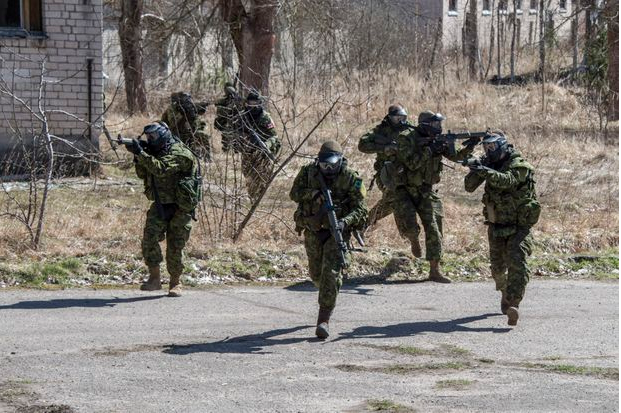By Scott Taylor
Sometimes it is important to take a good look in the mirror and judge ourselves by the same yardstick by which we judge others.
We have determined that Russian President Vladimir Putin is bad and we have a long list of his recent evildoings to make that case.
For example: In 2014, he annexed the Crimea. Since that juncture Russia has also supported the separatist rebels in eastern Ukraine with weapons and trainers and Russian intelligence meddled in the U.S. elections, thereby making Donald Trump the President. All very bad things.
To add insult to injury, Putin also went ahead and constructed what is known as the Crimea Bridge to connect his annexed territory to the Russian mainland.
This 18.1km span across the Kerch Straight was completed in just three years – from May 2015 till May 2018 at a cost of approximately $5 billion (USD). In addition to four lanes of vehicle traffic, the Crimea Bridge also includes two railway tracks. While everyone agrees that this was a major feat of engineering, the problem is that Putin did not ask permission to build this from the regime in Kiev. As the world has not recognized Putin’s annexation of Crimea, he has technically built a bridge to Ukraine sovereign territory. Again, pretty bad stuff.
Russia’s stated objective for building this lengthy span was to bring increased commerce and trade to the traditionally impoverished Crimea. In 2014 the average annual income of a Crimean resident was just $3,000 (USD), which was roughly 14% lower than the rest of Ukraine. It is Putin’s stated objective to bring his Crimean subjects up to an annual income of $15,000 and put them on par with the rest of Russia.
This could explain, in part, why the Crimeans voted so overwhelmingly in favor of joining Russia in the 2014 referendum.
For Putin, the reason to seize the Crimea was considered to be a strategic one. Since the time of the Czars, Russia’s Black Sea fleet has been based in the Crimean port of Sevastopol.
Following the collapse of the Soviet Union, Crimea was an autonomous region within the Republic of Ukraine, so Russia negotiated a long-term lease for Sevastopol. In 2010, Russia had extended that lease to 2042 with another five year option after that.
However, when the pro-West regime took control in Kiev in 2014, Ukraine threatened to cancel the deal and evict the Russian fleet. Hence the Russians were able to almost bloodlessly take military control of a military base, which they were already leasing.
Putin was, nevertheless, roundly denounced for this move, drawing the ire of then U.S. Secretary of State Hillary Clinton who declared: “You can’t just redraw the map of Europe.”
This was ironic in the extreme coming from Clinton because in 1999 her husband, then President Bill, did just that. In support of Albanian separatists the U.S. led a NATO 78-day air campaign bombing against Serbia.
The defiant Serbs refused to submit, and NATO had no stomach for a ground offensive. As a result, UN Resolution 1244 was signed wherein it was recognized that the disputed province of Kosovo would remain sovereign Serbian territory. Serbian security forces were withdrawn to allow NATO forces to provide interim security. The U.S. never had any intention of honouring the agreement and they immediately began building a massive military base in Kosovo. By August of 1999, two months after the ceasefire was signed, Camp Bondsteel was in full operation, complete with a huge post exchange (PX), a hospital, two gyms, two recreation centers, a Burger King, Taco Bell and an Anthony’s Pizza.
Despite this being Serbian sovereign territory, nobody asked the Serbs for permission to build it. In February 2008, Kosovo – without any referendum – made a unilateral declaration of independence. The U.S. was the first to recognize Kosovo as a nation, but there is no plan to remove Camp Bondsteel. In fact it has become a controversial detention center for the U.S. to hold what it terms to be “illegal combatants”, similar to the infamous base in Guantanamo Bay, Cuba.
In other words you can redraw the map of Europe, and you can build infrastructure on foreign soil without permission, as long as you are the U.S.
As for interfering in the Ukrainian civil war, how can Putin be evil for assisting one side while we pride ourselves on doing the exact same thing on the other? Canada in particular could have assumed a greater role as a mediator in Ukraine given our own experience with minority rights and our substantial community of ethnic Ukrainians. Instead, we have taken sides.
As for meddling with elections, the West doesn’t even pretend to be subtle. In 2001, the U.S. invaded Afghanistan, toppled the Taliban and installed a puppet President of their choosing. In 2003, the U.S. invaded Iraq, killed Saddam Hussein, and then failed miserably to establish a democracy. In 2011, the U.S. led assault in Libya helped the rebels depose and murder President Muammar Gadhafi. We didn’t even bother to try and establish a replacement government. All three of those nations remain engulfed in violent anarchy with millions of people dead as a result.
Now that is meddling.
Those idiot Russians are playing about on Facebook with fake news, making U.S. voters choose Trump over Clinton?
Bad guys indeed.




















